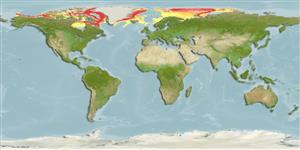Environment: milieu / climate zone / rango de profundidad / distribution range
Ecología
marino batidemersal; rango de profundidad 50 - 1400 m (Ref. 117245). Deep-water; 80°N - 58°N, 161°W - 104°E (Ref. 117245)
Northeast Atlantic: eastern central Greenland southeast to just north of the Faroes, Jan Mayen Island, around Spitsbergen and northern parts of Barents Sea. Arctic: Franklin Bay, North Western Territory and Alaska (Ref. 11976); also the Kara and Beaufort seas.
Tamaño / Peso / Age
Madurez: Lm ? range ? - ? cm
Max length : 51.7 cm TL macho / no sexado; (Ref. 11976)
Short description
Claves de identificación | Morfología | Morfometría
Vértebra: 96. Pelvic fins small (Ref. 4695). Uniformly or mostly dark, with 5-8 short, light cross-bands; band across nape, if present, straight, not curved forward; peritoneum dark, with dense brownish-black dots (Ref. 4695).
Body shape (shape guide): elongated.
Found on muddy bottoms (Ref. 4695). Benthic (Ref. 58426). Feeds mainly on epibenthic animals. With increase in size, shrimps and euphausiids are ingested in greater quantities but unlike L. reticulatus, its ingestion of smaller prey items does not decrease. Changes in feeding habit with size are relatively small (Ref. 13532).
Life cycle and mating behavior
Madurez | Reproducción | Puesta | Huevos | Fecundidad | Larva
McAllister, D.E., M.E. Anderson and J.G. Hunter, 1981. Deep-water eelpouts, Zoarcidae, from Arctic Canada and Alaska. Can. J. Fish. Aquat. Sci. 38(7):821-839. (Ref. 11976)
IUCN Red List Status (Ref. 130435: Version 2025-1)
Threat to humans
Harmless
Human uses
Herramientas
Special reports
Download XML
Fuentes de Internet
Estimates based on models
Preferred temperature (Referencia
123201): -0.7 - 2.6, mean 0.4 °C (based on 489 cells).
Phylogenetic diversity index (Referencia
82804): PD
50 = 0.5000 [Uniqueness, from 0.5 = low to 2.0 = high].
Bayesian length-weight: a=0.00275 (0.00171 - 0.00442), b=3.20 (3.06 - 3.34), in cm total length, based on LWR estimates for this species & Genus-body shape (Ref.
93245).
Nivel trófico (Referencia
69278): 3.4 ±0.44 se; based on food items.
Resiliencia (Referencia
120179): Muy bajo, población duplicada en un tiempo mínimo superior a 14 años (Preliminary K or Fecundity.).
Fishing Vulnerability (Ref.
59153): Moderate vulnerability (41 of 100).
🛈
